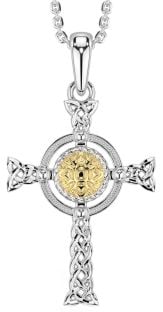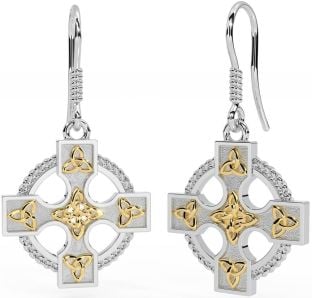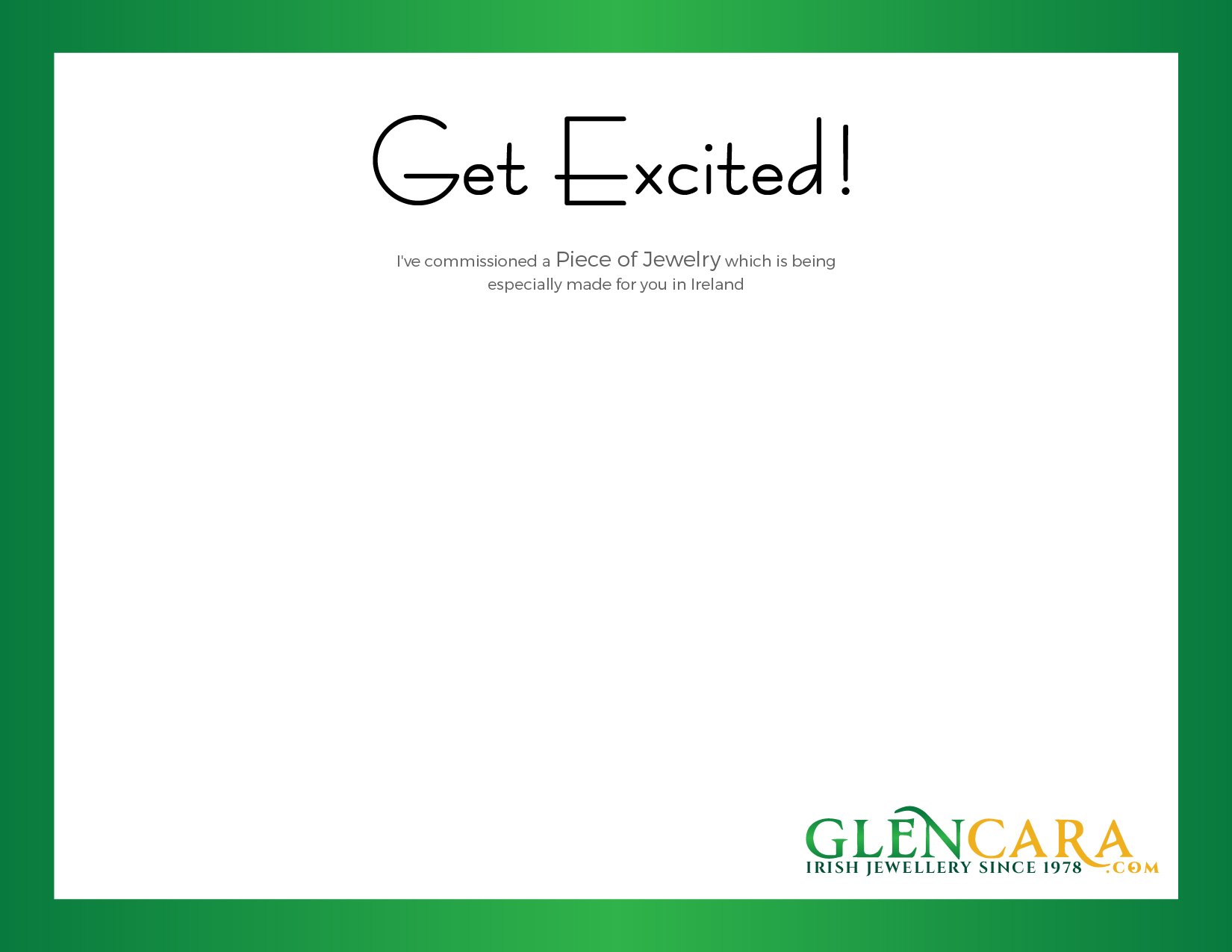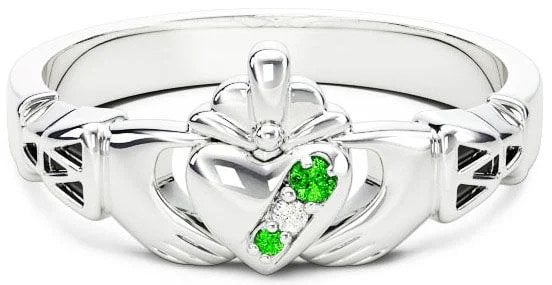Gold Silver Celtic Cross Warrior Trinity Knot Dangle Earrings
Free Shipping
Get it in USA by Saturday, Jun. 28 >
These Celtic Cross Warrior Trinity Knot Dangle Earrings [Selection_no_stone] The current selection is made from . . . [general] [Cross_short] [Warrior_short] [Trinity_short] [Celtic_short]
Item Details
These Celtic Cross Warrior Trinity Knot Dangle Earrings comes in Gold and Sterling Silver. The current selection is made from . . .
Individually handcrafted in Ireland. Guaranteed Quality.
Throughout Ireland & Scotland, the celts crafted these magnificent symbols in stone. Celtic Crosses pre-date Christianity and were first used by pagans to worship the sun. The Celtic Cross is now a symbol associated with Ireland and Christianity.
The design is inspired by one of the finest known works of Celtic art, thought to have been owned by a high status Celtic Warrior King, the "Ardagh Chalice" made in the 9th century AD.
The Trinity Knot is the most well-known Celtic design. It represents eternity and continuity. The three knots can represent the past, present and future of the relationship.
Celtic Designs have been around since ancient times and have long been applied to create fine art. Their distinctive patterns have appeared on stone, metalwork, in jewellery and on magnificent illuminated manuscripts. This beautifully crafted piece is a fine example of the exquisite work of the celts handed down from generation to generation.
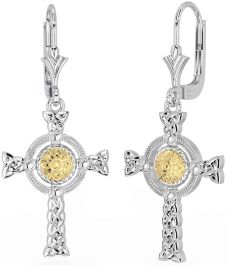
See Full Details
| Height (excl fitting) |
|
18 mm |
| Width |
|
13 mm |
| Metal |
|
|
Meaning of Design
Celtic Crosses: Throughout Ireland & Scotland, the celts crafted these magnificent symbols in stone. Celtic Crosses pre-date Christianity and were first used by pagans to worship the sun. In pagan times the circle of the Celtic cross represented the sun, being the center of their lives. It was not until the 4th century AD when it was introduced by the first Christian Roman Emperor Constantine, that the Celtic Cross was used to represent Christ's victory. During the great conversion of many pagans to Christianity, Christian Philosophers adapted the Celtic Cross and thought the meaning of the circle to represent Christ, the center of Christianity.
The Celtic Warrior: design is inspired by one of the finest known works of Celtic art, thought to have been owned by a high status Celtic Warrior King, the "Ardagh Chalice" made in the 9th century AD. Celtic Warriors were known to have been the most fierce in the ancient world, conquering Rome in 390 BC under the command of the Celtic Warrior King Brennus. An tale of the Celts comes from an account about an embassy of Celts from the Adriatic that caught up with Alexander the Great in 335 B.C. Apparently, the great man was impressed by their fearlessness, and he asked if there was anything the Celts truly feared. They replied, "Only that the sky should fall on our heads." The Ardagh Chalice is a two-handled silver cup, decorated with silver, gold, and enamel, assembled from 354 separate pieces. The names of the apostles are incised in a frieze around the bowl, below a girdle bearing inset gold wirework panels of animals, birds, and Celtic designs. Techniques used include hammering, engraving, Lost-wax casting, filigree applique, cloisonne and enamelling. It was found in 1868, together with four brooches, by two young boys, digging in a potato field on the south-western side of an ancient Celtic fortified dwelling know as a "rath" (ring fort), in County Limerick, Ireland. It had a golden cup within it, and four ornate brooches. Buried without the least protection as they were, the pieces must have been interred in a hurry, probably temporarily, as the warrior intended to return for them at a later time after a battle.
The Trinity Knot: Is the most well-known Celtic design, It decorated Ireland’s illuminated manuscripts such as the Book of Kells and is also found on Celtic crosses and Celtic stones throughout Ireland. It represents eternity and continuity. In Christianity it is used to represent the Holy Trinity: Father , Son and Holy Spirit. It is thought to show the continuous energy flow from life and death. The never ending knotwork can symbolise the love and never ending commitment given in the sacred blessings of the marriage vows. The three knots can represent the past, present and future of the relationship.
Celtic Designs: have been around since ancient times, created by the highly artistic Celtic peoples, Celtic designs have long been applied to create fine art. Their distinctive patterns have appeared on stone, metalwork, in jewellery and on magnificent illuminated manuscripts. This beautifully crafted piece is a fine example of the exquisite work of the celts handed down from generation to generation.

Customer Reviews
Verified Customer Reviews
from this merchant give
them a 4 or 5-Star rating.
How to Find Your Ring Size
Sizing Tips
Finding your ring size is very simple. For the most accuracy, measure the inside diameter of an existing ring (worn on the same hand and finger), and then find that measurement on the Ring Sizing Chart. If you don’t have a ring to use, follow these easy steps:
Step 1: Cut a strip of paper long enough to fit around your finger
Step 2: Wrap the paper around your finger, just above the knuckle, and mark the point at which the two ends meet
Step 3: Measure the paper from mark to mark
Step 4: Find that measurement on the Ring Sizing Chart to locate your size
Free Resizing
If you still don't know the exact ring size to order, rest assured, we provide one (1) FREE resizing of your ring within 60 days of the original shipping date. This includes items that have been engraved.
Mo Anam Cara: Means ‘My soul mate‘ (pronounced 'muh anem Ka-rah') copy
Mo shíorghrá: Means ‘My eternal love‘ sometimes used as a term for ‘soulmates’. (pronounced 'muh HEER-ggrawh') copy
Ghrá Dilseacht Cairdeas: Means ‘Love, Loyalty & Friendship‘ (pronounced ‘Graw Deal-shockt Char-dis’) copy
Ghrá go deo: Means ‘Love Forever‘ (pronounced ‘graw gu djo’) copy
Mo fhíorghra: Means ‘my true love’, one of the most romantic phrases around. (pronounced ‘ muh heer-graw’) copy
A Stór: Means ‘my treasure’, usually used to express affectionate friendship, especially for parent and children relationships. (pronounced ‘store’) copy
Le grá go deo: Means 'with love forever' (pronounced ‘leh graw gu djo’) copy
A Pheata: Means ‘a mother’s darling’, for a mother to express endearment for her children. (pronounced ‘fat-a’) copy
Mo Ghrá: Means ‘my love’, for relationships that are that little bit more serious! (pronounced ‘muh graw’) copy
Mo Chuisle: Literally means ‘my pulse’, for the person who makes your heart beat. Also can mean 'My Darling' (pronounced ‘muh Kooish-la') copy
A Ghrá mo Chroí: Means ‘my heart’s beloved’ or ‘the love of my heart’. (pronounced 'graw mu kree') copy
A Thaisce: Means ‘my treasure’, another version of ‘a stór’. (pronounced ‘hash-ka’) copy
Mo Mhuirnin: Means ‘my little darling’ or ‘my dear’, a more formal phrase (pronounced ‘muh mur-neen’) copy
A chéadsearc: Means ‘my first love’, or ‘my one and only’. (pronounced ’Khayd-shark') copy
A Chara: Means ‘friend’ (pronounced 'Kaw-rah') copy
A Chroí: Means ‘my heart’, a stronger version of the above, meant more for lovers to use. (pronounced 'kree') copy
Is tú mo ghrá: Means 'You are my love'. (pronounced 'Iss too mu graw' ) copy
Mo Shearc: Means ‘my love’ Another simple version of ‘mo ghrá’. (pronounced ‘ muh hark’) copy
Is tú mo rogha: Means 'You are my chosen one' (pronounced 'iss too mu row-ah') copy
A chuisle mo chroí: Means 'My heart’s beloved' (pronounced 'Kooish-la mu kree') copy
Ádhraím thú: Means'I adore you' (pronounced 'aw-reem hoo') copy
Mo Rúnsearc Literally means ‘my secret love’, there is no direct equivalent in English. (pronounced ‘ muh roon-hark’) copy
A stór mo chroí: Means 'Love of my heart' (prounouned 'ah sthohr muh kree') copy
Is tú grá geal mo chroí: Means 'You are the bright love of my heart' (pronounced 'Iss too graw gee-yal mu kree') copy
Mo ghrá thú: Means ‘you are my love’ (pronounced 'Muh ghraw hoo') copy
Táim i ngrá leat: Means 'I’m in love with you' (pronounced 'Tawm i graw lat') copy
Mo Leannán: Means 'My lover' (pronounced 'Muh lah-nawn') copy
Tá tú mo chéadsearc: Means 'You are my true love' (pronounced 'thaw too muh Khayd-shark') copy
Is tusa mo ghrá: Literally Means 'You are my love' (pronounced' Iss tus-ah mow-ghraw') copy
A Ghrá Geal: Means ‘my bright love’ (pronounced ‘graw gee-yal’) copy
A Chumann: Means ‘my sweetheart’ (pronounced ‘come-an’) copy
Seanleannán: Literally means ‘old love’, or ‘old flame’. (pronounced ‘shan-lan-awn’) copy
Meala: Means ‘Honey‘ (Prounounced 'M-alla') copy
Clann: Means ‘Children‘ (Prounounced 'Klan') copy
Iníon: Means ‘Daughter‘ (Prounounced 'in-yeen') copy
Mac: Means ‘Son‘ (Prounounced 'Mack') copy
Agra: Means ‘Love, Beloved or Sweetheart‘ (Prounounced 'Ag-rah') copy
Cairde: Means ‘Friends‘ (prounounced 'card ja') copy
Síor: Means ‘Always‘ (Prounounce 'Sheer') copy







